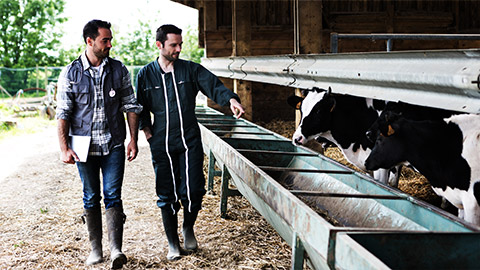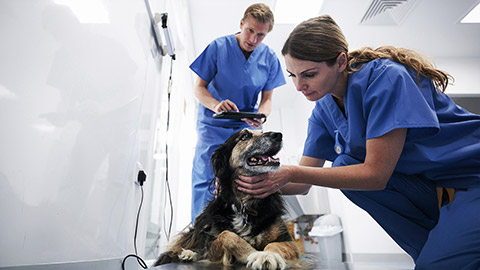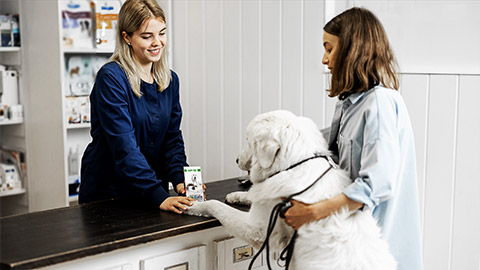When you have secured employment within the Animal Care Industry, you will be expected to abide by various stipulations that ensure animals are cared for ethically; customers/clients receive high-quality products and services, employees appropriately conduct themselves and individual tasks are competently performed.
Other laws protect your rights as an employee; these regulations must be followed by your employer/workplace. This broad collection of stipulations is known as Workplace Governance.
| General Professionalism | Ethical Considerations |
|---|---|
|
|
| Safety Practices | Animal Welfare |
|
|
Watch
Watch the videos below about appropriate workplace conduct.

Workplaces are governed by several pieces of legislation known as Acts. Acts can either be administered at the Federal or the State Government level. Regulations and Industry Codes of Practice further support acts. There are Codes of Conduct and Policies & Procedures at the workplace level.
- Acts - Formal descriptions of laws created by Parliament (Federal or State). Enforceable by the judicial system (police/courts).
- Regulations - Specific guidelines on how to apply the laws contained in an Act. Not usually enforceable by law in their own right.
- Industry Codes of Practice - Developed by industry associations. Best practice guidelines for the industry. Usually linked to membership or registration and may be audited.
- Workplace Code of Conduct - Specific to individual workplaces. Outlines ethical work practices. Often includes the business Vision and Mission.
- Policies and Procedures - Provide employees with guidelines on completing tasks.
Most legislation and regulations relevant to the animal care industry are administered at the State Government level. The Federal Government mainly concerns the welfare of animals being live-exported internationally and export-accredited abattoirs. This means there is some variety regarding the different stipulations in each state. If your workplace operates over numerous states or territories, ensure you are familiar with your state's relevant laws. Industry codes of practice are more likely to be administered nationally.
Watch
Watch the next video to explain how the Australian Legal System works
The main Acts (and a broad summary of their contents) that may be relevant to you are related to:
- Animal Welfare / Prevention of Cruelty - Welfare principles, Humane slaughter, Research animals, Captivity requirements, Cruelty prevention, and Penalties.
- Workplace Health and Safety - Employer and employee duty of care, Incident notification, Hazard identification, Inspection, and Enforcement measures.
- Environmental Protection - Conservation, Wildlife protection, Water, air and noise pollution, Hazardous waste, and Penalties.
Click on the icon in your relevant state/territory on the image below, in the pop-up box refer to the website link to view/download a copy of your local Animal Welfare / Prevention of Cruelty, Workplace Health, and Safety, or Environmental Protection legislation.
The applicable legislation/regulations include:
- Privacy (State-administered) - Collection and storage of personal information, Use, and disclosure of personal information.
- Anti-Discriminatory Laws (State-administered with some elements that come under Federal administration) - Protection against discrimination based on age, disability, race, sex, intersex status, gender identity, and sexual orientation.
No national laws apply to animal welfare, but all states and territories regulate it in their jurisdiction. You must make sure you check the local laws and regulations for your state/ territory.
Examples of an Industry Code of Practice include:
- Pet Industry Association of Australia (PIAA) - National Code of Practice.
- Australian Veterinary Association (AVA) - Members Code of Professional Conduct.
- Australian Animal Welfare - Standards and Guidelines (for livestock).
Reading
For more information on the industrial relations organisation that applies to the Animal Care Industry, check out PIAA (Pet Industry Association of Australia).
Explore
Next, explore DAFF, the Department of Agriculture, Fisheries and Forestry. The website has the Australian Animal Welfare Standards, which explain the implementation of the standards and what needs to be adhered to by livestock.
Check out the Australian Animal Welfare Standards Guidelines- DAFF
Minimum pay rates and conditions of employment within a particular industry are outlined within a Modern Award. These documents are part of the Fair Work Act 2009 (Federally administered) and the National Employment Standards (Federally administered), which ensure that all workers (in every industry) are treated fairly and paid correctly.
You must be aware of the contents of the Modern Award for your industry or know how to access the necessary information. If you believe you are not being paid correctly or are being treated unfairly, the Fair Work Ombudsman website provides information and support regarding Awards and Employee Entitlements: fairwork.gov.au
The current Modern Award covering people in the Animal Care Industry is the Animal Care and Veterinary Services Award 2020. Although you may be employed under a different type of award if your workplace is in a more specialised field.
You may also be employed under an Enterprise Agreement (EA) or an Enterprise Bargaining Agreement (EBA). These agreements are formed at the workplace (enterprise) level between the employer, the employees, and often their union. It sets out the terms and conditions of employment. EAs cannot pay less than the minimum wage in the applicable Modern Award, and often, they have terms, conditions, perks, and pay rates that are higher than the award.
The Animal Care and Veterinary Services Award 2020
The Animal Care and Veterinary Services Award 2020 is a modern award under the Fair Work Act 2009 that outlines the minimum employment standards and conditions for employees working in Australia's animal care and veterinary services industry. This award covers various roles, including veterinary nurses, animal attendants, and other animal care workers. Here is a brief overview of key aspects of the award:
Coverage
Who is Covered:
- Employees working in animal care and veterinary services, including veterinary practices, animal shelters, boarding kennels, pet grooming, and pet training services.
Types of Employment:
- Full-time, part-time, and casual employees are covered under this award.
Key Provisions
Minimum Wages:
- The award specifies minimum hourly rates for different classifications of employees based on their qualifications and duties.
- Wages are periodically reviewed and adjusted.
Hours of Work:
- Standard full-time hours are 38 hours per week.
- Provisions for part-time and casual work, including minimum engagement periods for casual employees.
- Single shift must not exceed 10 hours.
Overtime and Penalty Rates:
- Overtime rates apply for work beyond standard hours.
- Penalty rates for work performed on weekends, public holidays, and late-night or early morning hours.
Breaks:
- Entitlement to meal breaks and rest breaks, with specific conditions for their timing and duration.
Leave Entitlements:
- Provisions for annual, personal/carer’s, compassionate, and parental leave.
- Long service leave entitlements as per state or territory legislation.
Allowances:
- Various allowances include uniforms, travel, and allowances for handling dangerous or unhealthy tasks.
Employment Conditions
Classification Structure:
- A detailed classification structure defines different levels of employment based on skills, responsibilities, and qualifications.
- Examples include Veterinary Nurse, Animal Attendant, and Veterinary Surgeon classifications.
Termination of Employment:
- Notice periods are required for termination by either the employer or employee.
- Redundancy provisions and entitlements.
Workplace Flexibility:
- Provisions for flexible working arrangements to accommodate the needs of both employees and employers.
Training and Development:
- Encourage employers to support the professional development and training of their employees.
Compliance and Enforcement
Fair Work Ombudsman:
- The Fair Work Ombudsman (FWO) provides advice and enforces compliance with the award.
- Employees can seek assistance from the FWO for any disputes or issues regarding their employment conditions.
Record Keeping:
- Employers must keep accurate records of employees’ hours, wages, and leave entitlements.
Additional Resources
Fair Work Commission:
The Fair Work Commission (FWC) is the national workplace relations tribunal and provides information about awards, including the Animal Care and Veterinary Services Award.
Industry Bodies:
Industry bodies and professional associations can provide additional support and resources for employers and employees in the animal care sector.
For the most up-to-date information and specific details, refer to the full text of the Animal Care and Veterinary Services Award 2020 on the Fair Work Commission’s website or consult the Fair Work Ombudsman’s resources.

An individual organisation develops a Code of Conduct and often outlines, in one document, how the business maintains its ethical work practices. Examples of ethical work practices are Honesty, Integrity, Promise-keeping & Trustworthiness, Loyalty, Fairness, Concern for others, Respect for others, Law-abiding, Commitment to excellence, Leadership, Reputation and morale, and Accountability.
Staff are often required to read and agree to abide by the specifications of the Code of Conduct, which may outline behavioural and presentation standards for employees. Smaller organisations may not have a separate Code of Conduct. Rather, individual ethical work practices may be embedded into individual policies and procedures.
See an example from K9 Dog and Rescue of their Code of Conduct.
Introduction
This Code of Conduct outlines the standards of behaviour expected of all employees at [Facility Name]. Our mission is to provide high-quality care and ensure the welfare of all animals in our facility. Adherence to this code is essential to maintain a safe, professional, and compassionate environment.
1. Professional Conduct
1.1 Respect and Compassion
Treat all animals with kindness and patience.
Show respect to colleagues, clients, and visitors at all times.
1.2 Integrity and Honesty
Be truthful and transparent in all communications and actions.
Maintain confidentiality regarding client information and internal matters.
1.3 Reliability and Punctuality
Arrive on time for scheduled shifts and appointments.
Complete assigned tasks diligently and promptly.
2. Animal Welfare
2.1 Humane Treatment
Ensure all animals are handled with care and gentleness.
Avoid any form of physical punishment or harsh training methods.
2.2 Observation and Monitoring
Regularly monitor the health and behaviour of animals.
Report any signs of illness, injury, or distress to a supervisor immediately.
2.3 Nutrition and Hydration
Provide animals with clean water and appropriate food according to their dietary needs.
Follow specific feeding schedules and dietary guidelines.
3. Safety Practices
3.1 Personal Protective Equipment (PPE)
Wear appropriate PPE such as gloves, aprons, and masks when required.
Follow hygiene protocols to prevent the spread of diseases.
3.2 Handling and Restraint
Use proper techniques for handling and restraining animals to avoid injury.
Receive training in species-specific handling practices.
3.3 Sanitation
Maintain cleanliness in all areas where animals are housed and treated.
Regularly disinfect equipment, cages, and workspaces.
4. Workplace Conduct
4.1 Communication
Communicate clearly and respectfully with colleagues and clients.
Keep accurate records of animal care, treatments, and any changes in condition.
4.2 Team Cooperation
Work collaboratively with colleagues, sharing knowledge and supporting each other.
Respect the roles and expertise of all team members.
4.3 Conflict Resolution
Address any workplace conflicts professionally and constructively.
Seek mediation or guidance from supervisors when necessary.
5. Ethical Standards
5.1 Professional Boundaries
Maintain appropriate boundaries with clients and colleagues.
Avoid any behaviour that could be perceived as unprofessional or unethical.
5.2 Education and Training
Stay informed about best practices in animal care and welfare.
Participate in ongoing training and professional development opportunities.
5.3 Compliance with Laws and Regulations
Adhere to all relevant laws, regulations, and facility policies.
Report any suspected violations of laws or regulations to management.
6. Consequences of Misconduct
Violations of this Code of Conduct may result in disciplinary action, including termination of employment.
Serious breaches may also be reported to relevant authorities as required by law.
The concept of Misconduct
Misconduct in the context of working with animals refers to any behavior or action by an individual that violates ethical standards, laws, regulations, or professional guidelines in the care, handling, and treatment of animals. This can occur in various settings, including animal care facilities, veterinary practices, farms, zoos, research labs, and more. Misconduct can have serious consequences, not only for the animals involved but also for the individuals and organizations responsible for their care.
Types of Misconduct
Neglect
- Definition: Failure to provide animals with the basic necessities of life, such as food, water, shelter, and medical care.
- Examples: Leaving animals in dirty or unsafe conditions, not providing adequate food or water, or ignoring an animal's medical needs.
Abuse
- Definition: Intentional infliction of physical harm, pain, or suffering on an animal.
- Examples: Hitting, kicking, or otherwise physically harming an animal, using cruel training methods, or purposefully withholding food or water as punishment.
Improper Handling
- Definition: Handling animals in a way that causes unnecessary stress, fear, or harm.
- Examples: Rough handling during restraint, using inappropriate or unsafe equipment, or failing to follow proper procedures for handling fractious or aggressive animals.
Inadequate Record Keeping
- Definition: Failing to maintain accurate records of animal care, treatment, or research.
- Examples: Not recording medical treatments, neglecting to document animal behavior or health changes, or falsifying records to cover up neglect or abuse.
Unqualified or Inadequate Supervision
- Definition: Allowing untrained or unsupervised individuals to care for or handle animals, leading to potential harm or neglect.
- Examples: Assigning inexperienced staff to care for sick or aggressive animals without proper training or oversight.
Failure to Follow Protocols
- Definition: Ignoring established guidelines, laws, or ethical standards in animal care or research.
- Examples: Not adhering to animal welfare laws, disregarding veterinary advice, or violating ethical standards in animal research.
Animal Hoarding
- Definition: Keeping more animals than can be adequately cared for, often resulting in neglect and poor living conditions.
- Examples: Accumulating a large number of animals in a space that is too small or unsanitary, leading to health and welfare issues for the animals.
Consequences of Misconduct
- For the Animals: Misconduct can lead to physical and psychological harm, suffering, illness, or death for the animals involved.
- For the Individuals: Those found guilty of misconduct can face legal penalties, loss of licenses or certifications, job loss, and damage to their professional reputation.
- For Organisations: Animal care facilities or businesses can face fines, closure, loss of accreditation, and damage to their public image.
Preventing Misconduct
- Education and Training: Ensuring that all staff working with animals are properly trained in animal care, handling, and welfare standards.
- Clear Policies: Establishing and enforcing clear protocols for animal care and handling, with regular audits and checks to ensure compliance.
- Reporting Mechanisms: Implementing a system for reporting and addressing concerns about animal welfare or staff behavior without fear of retaliation.
- Ethical Leadership: Promoting a culture of compassion, respect, and ethical behavior in all interactions with animals.

Policies and procedures are developed by an individual organisation or even a specific department within that organisation and usually relate to a specific topic or individual task. They provide overarching guidelines and step-by-step processes, respectively.
Policies
Standards or regulations put in place by an organisation. They can be presented in hard or digital copy and should always be accessible within the workplace. Policies often stipulate how the workplace will implement and abide by relevant legislation; for example, a workplace may have a Privacy Policy or an Anti-Discrimination / Equal Opportunity Policy. Generally, workplace policies are implemented by a set of procedures.
Examples of workplace policies that you may be required to abide by are:
- Animal Welfare - Includes feeding and watering, animal handling, housing setup and maintenance, exercise, and socialisation needs.
- Environmental Sustainability - This includes properly using and disposing of potentially hazardous substances and reducing energy/water use.
- Infection Control - includes clinical waste disposal, handwashing, and aseptic techniques.
- Cleaning and Hygiene - includes cleaning schedules, cleaning techniques, cleaning equipment, and sanitising agents.
- Workplace Health and Safety - includes the duty of care for employers and employees, evacuation procedures, and hazard/risk control.
- Anti-discrimination and anti-bullying - include the protection of employees regardless of disability, race, gender, religion, nationality, or sexual orientation.
- Privacy - Includes provisions for the protection of employee and client personal information.
Procedures
Otherwise known as Standard Operating Procedures (SOPs), are detailed documents that outline how to safely and effectively complete a task step-by-step. SOPs are easy to follow and include details such as potential health and safety issues and control methods for minimising the risk associated with potential hazards. SOPs ensure that existing staff members consistently complete workplace tasks and that all new staff members know organisational standards and requirements. SOPs should be readily available to all staff members and consulted when completing an unfamiliar task.
Task Checklists
Checklists are used in the workplace to ensure that certain duties, such as maintenance and/or cleaning tasks, are completed as required. Task lists may be divided into separate checklists based on the frequency with which the task must be completed (for example, daily, weekly, or monthly) or divided into separate room lists. For example, a veterinary clinic may have separate checklists for tasks to be completed in the surgery room, consulting room, waiting area, etc.… When working from a checklist, you must consult your workplace SOPs to effectively complete unfamiliar tasks. You must date and sign your name from a checklist once you complete any task so your colleagues know the task has been completed for that day, week, or month. This ensures others are not wasting time by repeating cleaning or maintenance tasks.
Watch
The next videos explain policies and procedures and the importance of them.
The next video is a small Ted Talk explaining the importance of the Checklist.
In an animal care workplace, comprehensive policies, procedures, and checklists ensure the health and safety of animals and staff, maintain operational efficiency and comply with legal requirements. Here are examples of each:
Animal Welfare Policy
- Commitment to humane treatment of all animals.
- Guidelines for handling, housing, and enrichment.
- Procedures for monitoring animal health and behaviour.
Health and Safety Policy
- Workplace safety rules and regulations.
- Use of Personal Protective Equipment (PPE).
- Emergency procedures for accidents or injuries.
Infection Control Policy
- Protocols for preventing the spread of infectious diseases.
- Sanitation and disinfection procedures.
- Quarantine procedures for new or sick animals.
Client Confidentiality Policy
- Protection of client and animal information.
- Guidelines for record-keeping and data privacy.
- Procedures for handling breaches of confidentiality.
Training and Development Policy
- Requirements for staff training and continuing education.
- Opportunities for professional development.
- Evaluation of training effectiveness.
Intake Procedure
- Steps for admitting new animals into the facility.
- Initial health assessments and vaccinations.
- Documentation and record-keeping.
Feeding and Nutrition Procedure
- Daily feeding schedules and dietary requirements.
- Procedures for preparing and serving food.
- Monitoring and recording food intake.
Medication Administration Procedure
- Guidelines for storing, handling, and administering medications.
- Record-keeping for dosages and administration times.
- Procedures for dealing with missed doses or adverse reactions.
Cleaning and Disinfection Procedure
- Daily, weekly, and monthly cleaning schedules.
- Approved cleaning agents and methods.
- Procedures for cleaning animal housing, equipment, and common areas.
Emergency Response Procedure
- Steps to take during medical emergencies (e.g., animal injuries, health crises).
- Evacuation plans for fire, natural disasters, or other emergencies.
- Contact information for emergency services and key personnel.
Daily Care Checklist
- Feeding and watering times.
- Cleaning tasks (cages, litter boxes, common areas).
- Health checks and observations.
Intake Checklist
- Documentation (identification, vaccination records).
- Initial health assessment.
- Quarantine arrangements.
Medication Administration Checklist
- Medication name and dosage.
- Time and date of administration.
- Staff initials/signature.
Cleaning and Disinfection Checklist
- Areas to be cleaned (kennels, cages, exam rooms).
- Cleaning products used.
- Date, time, and staff responsible.
Safety and Equipment Checklist
- PPE availability (gloves, masks, aprons).
- Functionality of equipment (scales, examination tools).
- Fire extinguishers and first aid kits.
Example of a Daily Care Checklist
Purpose of Policies and Procedures
The purpose of a policy in any organisation, including those that work with animals, is to provide clear guidelines and establish standards for decision-making, actions, and behaviour. Specifically, in an animal care setting, policies serve several important functions:
1. Ensuring Consistency
|
2. Promoting Animal Welfare
|
3. Improving Safety
|
4. Legal and Regulatory Compliance
|
5. Clarifying Roles and Responsibilities
|
6. Guiding Decision-Making
|
7. Improving Efficiency and Accountability
|
8. Supporting Training and Development
|
9. Enhancing Communication
|
The table below shows some examples of policies you may come across when working with animals and their purpose.
In the next table are some examples of procedures you may come across when working with animals and their purpose.

A roster is generally a list or plan of hours to be worked by each employee on any given day. Rosters exist to ensure an appropriate number of employees will be available for the duration of an organisation's trading hours. Rosters are generally produced by senior staff members or management in consultation with employees. It is in management's best interest to ensure a healthy work-life balance can be maintained around an employee's work hours. Clear and detailed rosters ensure no confusion and all employees will be present for their shifts. Rosters may also detail an employee's total hours for the period indicated.
Example of a Roster from an Animal Care Facility:
Example of a Daily Task Assignment Roster:
Example of a detailed Daily Task Roster:
| Employee Information | Tasks |
|---|---|
| Jane Doe 8:00 am-4:00 pm | Morning Feeding: 8:00 AM Health Checks: 9:00 AM Cleaning Cages/Kennels: 10:00 AM Lunch Break: 12:00 PM Exercise/Enrichment: 1:00 PM Afternoon Feeding: 3:00 PM Record Keeping: 4:00 PM |
| John Smith 10:00 am-6:00 pm | Cleaning Cages/Kennels: 10:00 AM Health Checks: 11:00 AM Lunch Break: 12:00 PM Exercise/Enrichment: 1:00 PM Afternoon Feeding: 3:00 PM End-of-Day Cleaning: 5:00 PM Closing Duties: 6:00 PM |
| Alice Brown 9:00 am-5:00 pm | Cleaning Cages/Kennels: 9:00 AM Health Checks: 10:00 AM Lunch Break: 12:00 PM Exercise/Enrichment: 1:00 PM Afternoon Feeding: 3:00 PM Record Keeping: 4:00 PM |
| Bob Johnson 7:00 am-3:00 pm | Morning Feeding: 7:00 AM Health Checks: 8:00 AM Cleaning Cages/Kennels: 9:00 AM Lunch Break: 12:00 PM Exercise/Enrichment: 1:00 PM Afternoon Feeding: 3:00 PM |
Quality Assurance is maintaining compliance with the various sections of workplace governance. Examples of a quality assurance framework include:
- Internal and external auditing.
- Applying for and maintaining accreditation/registration with an industry association.
- Training sessions and testing/assessment.
- Policy and procedure manuals.
- Employee performance reviews.
Workplaces can manage their Quality Assurance processes internally or with a specialist consulting company. Some industries are more regulated than others, and therefore, the level of quality assurance may be more stringent, and ramifications for non-compliance may be quite severe.
| Animal Welfare Audit | Health and Safety Audit | Medication and Treatment Audit |
|---|---|---|
| Purpose: To ensure the animals are treated humanely, and their welfare needs are met. | Purpose: To ensure the safety of staff, visitors, and animals, as well as compliance with health and safety regulations. | Purpose: To ensure proper storage, handling, and administration of medications and treatments. |
|
Key Components:
|
Key Components:
|
Key Components:
|
| Compliance Audit | Compliance Audit | Sanitation and Hygiene Audit |
|
Purpose: To ensure adherence to relevant laws, regulations, and industry standards. Key Components:
|
Purpose: To ensure adherence to relevant laws, regulations, and industry standards. Key Components:
|
Purpose: To ensure that the facility maintains high standards of cleanliness to prevent the spread of disease. Key Components:
|

As part of your duties, you may be required to gather personal information from clients. This may include:
- Contact Information - Addresses, Phone Numbers, Email Addresses.
- Financial Information - Credit Card Numbers, Bank Details, Payment History, Credit Checks.
- Animal Profile Information - Identifying Characteristics, Registration Status.
- Animal Health Care Information - Vaccination History, Medical Procedures.
The main consideration you must abide by regarding record-keeping and privacy is the security of this personal information. Always ensure that you do the following:
- Keep paper-based records in locked filing cabinets/drawers.
- Use passwords for computerised programs such as databases and maintain password security.
- Proofread all outgoing correspondence, especially emails, to ensure the recipient is the correct person.
Case Study
See below an example of a Client Registration Form that Happy Paws Animal Care Facility uses for animals and their owners when they enter the centre. As you can see, there are specific sections in the form like
- Client/ Owner Information
- Emergency Contact for the owner/ pet
- Animal Information
- Services required
- Consent and Agreement

In this course, you will learn more about workplace communications. It is important to familiarise yourself with your workplace policies and procedures for communication.
You will undertake various types of communication with other staff members and clients or customers. These include:
- Face-to-face communication
- Written correspondence, such as letters or emails
- Phone calls
It is also important to remember that, like animals, we communicate non-verbally with our body language. Be aware of your posture and body movements when communicating.
Teamwork is also important, especially when risks or hazards are present. Maintaining open communication can assist in maintaining positive and constructive teamwork.
If you see someone struggling or have completed your required tasks, lend a hand!
Each workplace will have a structure that indicates who your supervisor is, team leaders, and who you should report things to. It is important to familiarise yourself with this and ensure you are reporting to the appropriate person.
A workplace structure or line of reporting may look something like this:
- Owner/Operator
- Workplace supervisor
- Team supervisor
- Team leaders
- All other staff
Or:
- Veterinary Manager or Practice Manager
- Veterinarians
- Nursing Manager
- Team leaders
- Veterinary Nurses
- Animal Attendants

As an individual with a Certificate II in Animal Care, you will be able to go into an animal care workplace in an entry or support role. In most workplaces, your role or title will be Animal Attendant or Kennel's hand. This does not mean you are limited to these roles; however, some workplaces may require you to do additional study to move into other positions.
The types of tasks or responsibilities you may be asked to complete include but are not limited to:
- Cleaning and maintenance of animal housing
- Feeding and watering animals
- Handling and/or restraining animals for treatment or medications
- Exercising animals
- Developing and implementing enrichment strategies
- General cleaning and maintenance of the animal care facility
- Laundry
- Client interactions, including the admission and discharge of animals into the facility
- Restocking includes making up chemicals or solutions.
A typical day working as an animal attendant will look something like this:
At the start of your shift, you would make your presence known and confirm your responsibilities with your supervisor or manager. Once you get to know the workplace, you may understand the responsibilities that must be completed daily.
From here, you should go around and check on each animal. Sometimes, you may also get ‘rounds’ for the animals. This is done in most veterinary clinics. Rounds are when you get a handover with information about each animal and its needs. For example, if they are being walked, what is their temperament? You should check each animal’s file or cage card to ensure you know when they need to be walked or fed or if treatment is required. Each animal should have a fresh bowl of water and, when required, appropriate meals. While you are going around checking on each animal, you should also take note of which cages require cleaning. Once your checks and/or rounds are complete, you must go around and clean each cage according to your workplace procedures.
Most workplaces will have a schedule already worked out. For example, they may require that all animals be walked every 4 hours or once in the morning and once at night. Feeding may only be done in the morning unless stated otherwise, or it may happen at midday and 8 pm before you leave. You must become familiar with your workplace policies and procedures and follow these on shift. On top of exercising animals, you may need to implement some enrichment strategies, especially for boarding animals.
Between cleaning the cages, exercising animals, and feeding them, you must keep your eye on the laundry. Multi-tasking can be a helpful skill to have. If you are walking towards the laundry, pop your head in and put a cycle on if there is a build-up of washing. You must also clean animal dishes, litter trays and other kidney dishes. You may also be required to clean and pack up areas after use. This may include equipment that is used. You will need to manage the waste and frequently change the bins.
At the end of your shift and throughout your shift, you should keep an eye on the level of products on the floor and restock anything that is getting low or depleted. This will include cleaning chemicals and making them up to the correct dilution. If you are unsure, you should always ask a manager or supervisor what the dilution rate should be. Products can have different dilution rates for different levels of cleaning.
Depending on your workplace, you may also have additional tasks to complete, like grooming animals.
There is always something to be done, and lots of cleaning needs to occur in animal care facilities. If you are unsure or run out of things to do, check in with your manager or supervisor.
Typical Day of an Animal Attendant
6:30 AM - 7:00 AM: Morning Arrival and Preparation
Clock in and review the day's schedule.
Check messages and updates from the previous shift.
Prepare food and supplies for the morning routine.
7:00 AM - 8:00 AM: Morning Feeding and Watering
Feed all animals according to their specific dietary needs.
Ensure all animals have fresh water.
Record food intake and any unusual behaviours.
8:00 AM - 9:00 AM: Health Checks and Medication Administration
Perform visual health checks on all animals.
Administer any prescribed medications and treatments.
Document health status and any concerns in the medical records.
9:00 AM - 10:30 AM: Cleaning and Sanitation
Clean animal enclosures, including kennels, cages, and litter boxes.
Disinfect feeding bowls, toys, and common areas.
Dispose of waste properly and ensure sanitation protocols are followed.
10:30 AM - 11:00 AM: Break
Take a scheduled break, ensuring coverage is maintained.
11:00 AM - 12:30 PM: Exercise and Enrichment
Provide animal exercise and playtime, including walks, play sessions, and mental stimulation activities.
Rotate toys and enrichment items to keep animals engaged.
Monitor interactions to ensure safety and well-being.
12:30 PM - 1:00 PM: Lunch Break
1:00 PM - 2:00 PM: Afternoon Feeding and Watering
Provide a second feeding for animals with specific dietary schedules.
Ensure fresh water is available for all animals.
Record food intake and any notable behaviours.
2:00 PM - 3:00 PM: Grooming and Care
Perform grooming tasks such as brushing, bathing, nail trimming, and ear cleaning.
Check for any signs of parasites or skin issues.
Document any findings and report to the supervisor.
3:00 PM - 4:00 PM: Client Interaction and Adoption Support
Assist clients with inquiries, adoptions, and visits.
Conduct tours of the facility and explain care procedures.
Handle administrative tasks related to adoptions and animal intake.
4:00 PM - 4:30 PM: Afternoon Health Checks and Medication Administration
Perform another round of health checks and administer evening medications.
Update medical records and note any changes in condition.
4:30 PM - 5:00 PM: Cleaning and Preparation for Next Shift
Clean and disinfect work areas, equipment, and animal enclosures.
Prepare food and supplies for the next shift.
Complete daily reports and update the logbook with important information.
5:00 PM - 5:30 PM: End-of-Day Duties
Conduct a final check to ensure all animals are safe and comfortable.
Communicate any urgent issues to the next shift or supervisor.
Clock out and leave the facility.
Key Responsibilities
- Feeding and Watering: Ensuring all animals receive the correct diet and have access to fresh water.
- Health Monitoring: Conducting regular health checks and administering medications as needed.
- Sanitation: Maintaining cleanliness in all areas where animals are housed and treated.
- Exercise and Enrichment: Providing physical and mental stimulation for the animals.
- Grooming and Care: Attending to the grooming needs of the animals.
- Client Interaction: Assisting clients with inquiries, adoptions, and visits.
- Record Keeping: Maintaining accurate records of animal health, behaviour, and care activities.
Watch
Watch the video below on the day in the life of an animal attendant at the RSPCA.

Industry work conditions can be found in the Animal Care and Veterinary Services Award 2020 as set by Fair Work.
With any job, it is important to demonstrate a good work ethic. So, what does this mean?
- Attitude
Positive, reacting appropriately. - Attendance
Reliable. Show up and be on time. - Appearance
Professional in the you act and look. - Ambition
Initiative, adding value. - Acceptance
Respect others, and follow the rules. - Appreciation
Gratitude for others, selfless. - Accountability
Honesty, integrity.
Your appearance is extremely important, especially when interacting with clients. All employees should follow these simple rules for personal hygiene:
- Hair should be tied back and off your face. It should be neat.
- Makeup should be kept to a minimum.
- A name badge may be required.
- Shower daily and use deodorant.
- Clothes should be neat, tidy and clean. If you are required to wear a uniform, it should be worn correctly.
- Short and clean nails. Acrylic/fake nails and nail polish rules will differ in each workplace. For hygiene and aseptic reasons, the general rule of thumb is no.
- Long, loose-fitting pants. This is to avoid an animal scratching or biting your legs.
- Non-slip enclosed shoes.
